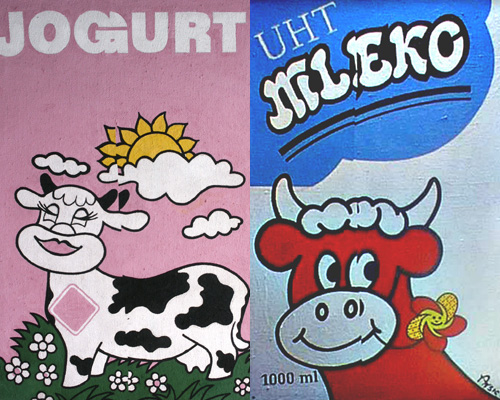|
 |
Srdjan
Arsic - Artist
The
images in Srdjan Arsic’s work come from popular culture and the
everyday. His Pop Art images of milk and yoghurt cartons and other types
of product packaging recall the prints of Andy Warhol, with the difference
that upon closer inspection, his works are very carefully hand-painted.
His paintings recall the production lines of Warhol’s image-making
factory, whilst revitalising the pop image by returning to it a sense
of autonomy, a trace of the artist’s hand. Each painting is completely
unique.
The forms of his sculptures are also echoes of the quotidian: milk cartons and sugar packets, delicately carved from marble, so that the detail and intricacy of each and every most tiny crease can be seen. Again he gives the object back a sense of its own difference. It is now rare and no longer common.
Srdjan’s works provoke a new discussion of Pop art, through a process of reinvention and the return of a hands-on skill, invigorating the impersonal and mechanical with the undisputed sense of individual craft
“Art and society have always been closely tied, and their degenerate offspring is mass culture (adverts, packaging, comic strips, films). In capitalist society the advert is always well calculated, presented and filmed, and at all times aggressive. What I deal with in my own work is that view of mass media in ex-Communist states, which are today countries in transition. In totalitarian Communist states, it was the government-run organisations that had control of the marketplace; there was no competition or choice for the consumer (everyone being equal). From this arose a naïve, and on the one hand attractive, though sometimes somewhat idiotic, unconsidered and psychedelic design. Smiling actors and their products thus created a parallel psychedelic world which is slowly disappearing with the onset of a shrinking globe and a growing capitalist society.
“I am of the opinion that you can create a good picture of the social and economic situation of a country through the imagery of their products. Countries of the Eastern Block have developed their own distinctive style, often naïve and comical, without the intention of following trends in marketing or propaganda.
“This
last decade has seen the construction of a new global semiotic. We know
that the wheels of history turn through full circles; hieroglyphic scripture
is considered to be primitive and outdated with regard to the signs and
signifiers we use today. Even if the attempts of the Russian doctor Zamenhof
to make Esperanto an international language failed, consumers from all
over the world are under the pressure of globalisation to unconsciously
create a new international hieroglyph of consumerism. We already have
these new hieroglyphs inscribed upon the packaging of any given product.
Of course, we should bear in mind that the new hieroglyphs also include
road signs, signs on electronic machines and computer programmes (Hieroglyphs-
a language expressed imagery, a picture-semiotics). The themes of my paintings
are variations on this not yet precisely defined hieroglyphic language,
which is increasingly used by the consumer community of this planet.”